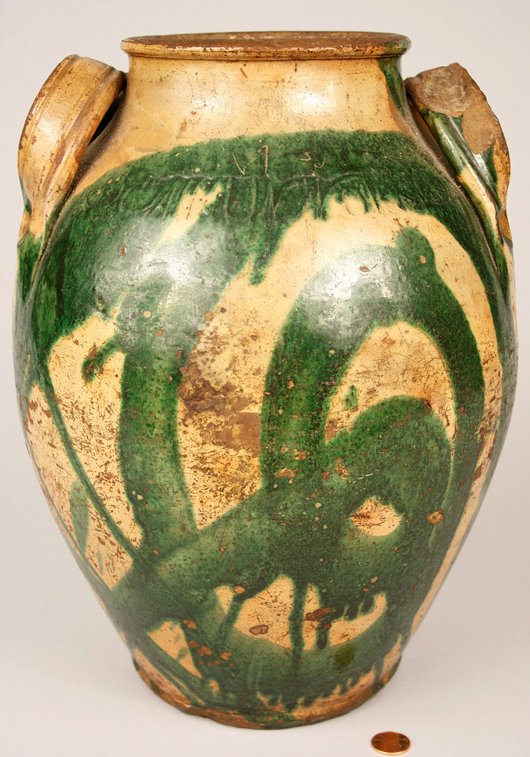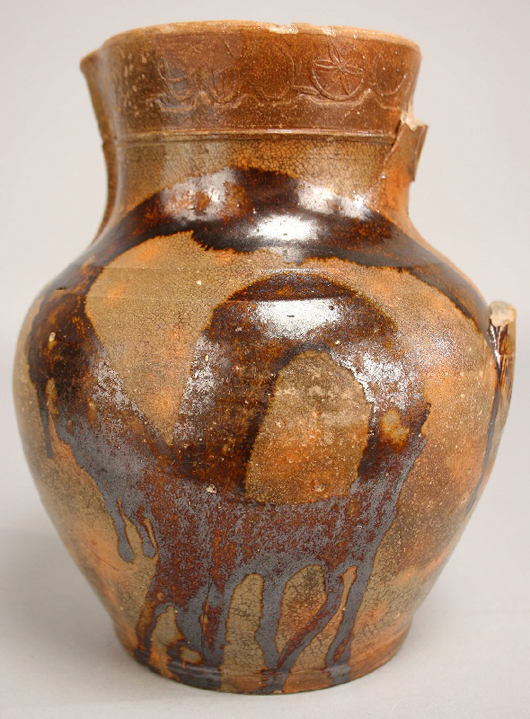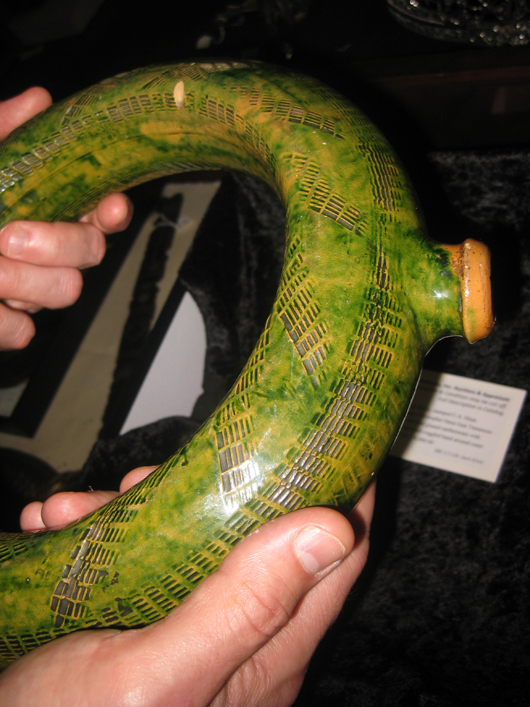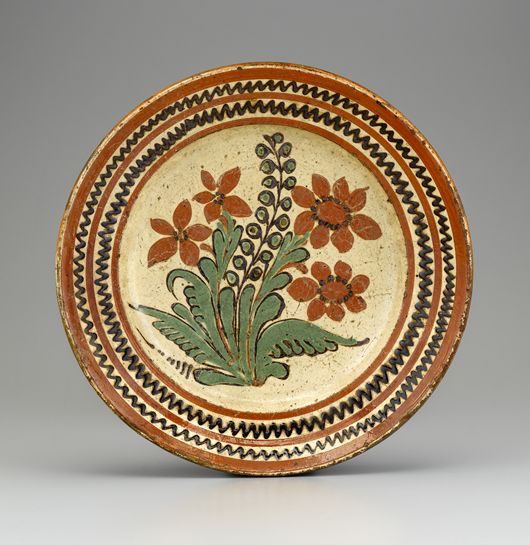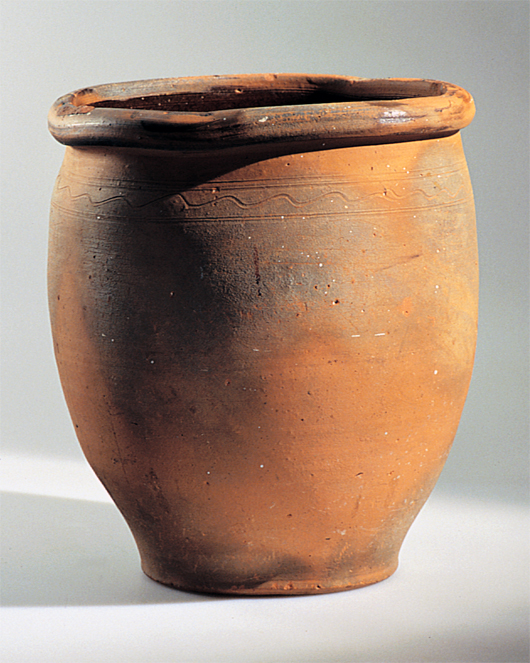The pottery prize of the Case auction was this rare ring bottle by Christopher Alexander Haun (1821-1861), which sold for $30,680. The important example of East Tennessee pottery is headed for MESDA in Winston-Salem, N.C., where it will go on display in October 2015. Image courtesy Case Antiques.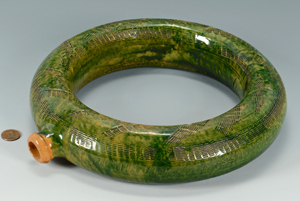
In July, a superb earthenware ring bottle marked “Haun” sold for $30,680 (est. $16,000-$18,000) at a Case Antiques estate auction in Knoxville, Tenn. As fresh as the day it was made, the form was glazed in a bright snake green produced by copper oxide and covered in complex impressed patterns. Purchased with a purpose in mind, the unusual form is headed for the Museum of Early Southern Decorative Arts in Winston-Salem, N.C., where it will go on display in the William C. and Susan S. Mariner Southern Ceramics Gallery scheduled to open in October 2015.
The maker’s mark is that of Christopher Alexander Haun (1821-1861), another artisan with an interesting history of leaving his workshop to fight for what he believed in. Case is well-known for its finds in the field of regional painting, furniture and decorative arts. The ring bottle turned up at a local appraisal fair and was consigned by a family who had carefully preserved it because they knew it had a connection to the Civil War. Catalog entries at the firm frequently go beyond aesthetic description to make important contributions to our understanding of the historical background of the objects.
Christopher Haun belonged to a related group of potters in Greene County, which also included other established makers such as William Hinshaw and J.A. Low as well his younger brother Lewis Haun. Like many people in eastern Tennessee, Haun was strongly Union in his sympathies when the Civil War began. Several potters were among the raiding party who burned a Confederate railroad bridge at Lick Creek, an act for which five men including Haun were executed in 1861.
He wrote a letter to his wife from a Knoxville jail telling her to contact his potter friends about finishing off his current wares and then to sell the equipment in his workshop. John Case credits East Tennessee pottery expert Carole Wahler for her detailed research on the craftsman which has led to a better understanding of his work; an entry on the Haun Pottery appears on her website www.cwahlerantiques.com.
Case stresses the importance of Haun and his work: “We’re talking about this extraordinary potter, who I think is one of the finest potters of the 19th century. In a few short years, a number of pieces have surfaced that would be considered masterpieces of the ceramic art.” He stresses that only recently have these facts about Haun’s life and career emerged to provide a background for his beautifully crafted pots. In May 2010, the auction house sold a rare pitcher decorated in lead glaze with manganese or iron oxide loop designs for $9,988 (est. $3,500-$4,500). In the fall that year, they offered a well-shaped redware jar covered in cream slip and decorated with a bold green loop pattern that brought $36,800. Both were marked “C.A. Haun.”
The circular form of the ring bottle allowed it to be tied to a saddle or hooked over an arm for carrying. After the auction, Case noted that this was the only known example of the form from the Haun pottery works: “And I’m afraid it will be for the future – it’s unbelievably rare. This green bottle is so elegant in form and perfectly crafted. It was difficult to make these ring bottles; two halves of clay had to be joined at a seam so the section is perfectly circular. On top of that, he ran a band around the outer circumference and then added the stamps – surely he was showing off. I don’t know of a finer example in the South or in the North. And it’s redware on top of which he put down these amazing glazes of lead and copper oxide; you can’t really do that with stoneware. It looks like it was made two weeks ago.” Collectors attending next February’s Williamsburg Antiques Forum can look forward to a lecture on Haun and his pottery by John Case.
Skillful execution and excellent condition naturally led to the purchase of the Haun rarity as an important exhibit for the new gallery planned for MESDA. Robert Leath, chief curator and vice president, collections & research, at Old Salem Museums & Gardens wrote: “With the addition of the ring bottle to the Mariner Collection, we are delighted that both he and his pottery will be represented in the Mariner Gallery when it opens next year in October 2015.”
A recent MESDA announcement about the gallery noted that the installation “will be the first permanent museum gallery of its kind devoted solely to early southern pottery, combining masterpieces from both the museum’s public and the Mariners’ private collections. … Together, these objects will tell a more complete story of the southern ceramics traditions and how it evolved from the early 18th century to the mid-19th century than has ever been told before, detailing the lives of individual potters from Duche to Aust to Chandler, and all the major centers of southern ceramics production from Baltimore to Edgefield to western Tennessee.”
Currently, Case presents two large estate auctions a year at their headquarters in the historic Cherokee Mills building in Knoxville. The next major auction will be held in Jan. 24. For more information visit www.caseantiques.com.
To follow the activities of the Museum of Early Southern Decorative Arts and the Old Salem Museums and Gardens, visit www.mesda.org. On Oct. 23-25, the eighth biennial MESDA Conference with presentations on Southern material culture and decorative arts will be held at the Kentucky Historical Society in Frankfort.
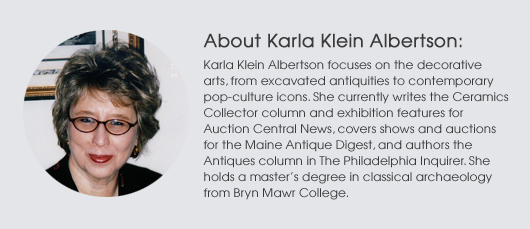
ADDITIONAL IMAGES OF NOTE
The pottery prize of the Case auction was this rare ring bottle by Christopher Alexander Haun (1821-1861), which sold for $30,680. The important example of East Tennessee pottery is headed for MESDA in Winston-Salem, N.C., where it will go on display in October 2015. Image courtesy Case Antiques. The potting skill of Christopher Haun can be clearly seen in the graceful shape of this 13-inch high jar with attached loop handles. The jar, covered with cream slip decorated with an abstract design in green, sold for $36,800 four years ago. Courtesy Case Antiques The stamped mark of C.A. Haun appears on the jar’s shoulder underneath a splash of copper oxide glaze. Image courtesy Case Antiques. Although missing its handle, the redware pitcher clearly bears the stamp of C.A. Haun by the compass star on the upper rim; the lot brought $9,988 at Case in 2010. Image courtesy Case Antiques. John Case shows off the perfect condition and circular form of the Haun ring bottle. An elaborate impressed pattern enlivens the vessel’s green-glazed surface. Image courtesy Case Antiques.
